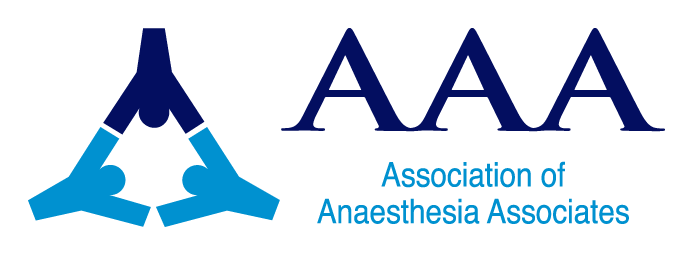Scope of Practice for Anaesthesia Associates
Please note many documents will refer to Physicians’ Assistant (Anaesthesia) – this was the previous title of the profession. The documents including curriculum and scope of practice continue to be valid and apply to Anaesthesia Associates.

The curriculum is the result of collaborative working between:
The detail of the curriculum itself is the result of close collaboration between the Royal College of Anaesthetists, the former NHSU and the University of Birmingham, and builds on early work conducted by Dr David Greaves for the Royal College and overseas nurse anaesthetist curricula. A wider Reference Panel including PA(A) representation has been able to comment on and influence each stage of development of the curriculum.
AAA Statement on Scope of Practice for an AA on qualification – 2016
The AAA fully supports the RCoA and AAGBI position statement regarding the scope of practice for an AA [PA(A)] on qualification, published in 2016. AAs undergo a relatively short training program of 27 months in which it is impossible to cover all areas of modern anaesthesia. However, through further training and assessment, AAs are able to perform functions for which they were not initially trained and are traditionally only carried out by anaesthetists.
The AAA would like to reinforce its support for further development and expansion of the AA role to areas not covered in AA initial training, whilst ensuring patient safety and appropriate supervision of AAs in all areas of practice. We would expect further development to have robust local governance in place and teaching led by consultant anaesthetists, thereby ensuring patient safety is maintained. Once statutory regulation is in place for AAs, it is expected that nationally recognised role development can take place with full endorsement by key stakeholders.
We would encourage departments of anaesthesia to develop new ways of working, incorporating AAs as part of a multi-disciplinary team, delivering anaesthesia services.
The AAA position on the ‘Scope of Practice for a PA(A) on qualification’; the statement is a set of guidelines based on the abilities of an AA after 27 months training. It is not intended to limit practice and development, particularly as individual AAs become more experienced and gain new skills.
Core purpose
To provide anaesthetic services to patients requiring anaesthesia, respiratory care, cardiopulmonary resuscitation and/or other emergency, life sustaining services within the anaesthesia and wider theatre and critical care environments.
The Association of Anaesthesia Associates supports the development of competencies outside the initial scope of practice by Departments of Anaesthesia through their local Governance structures.
Examples of AA extending their roles across the UK in 2018.
As reported by those registered on the voluntary register, held by the Royal College of Anaesthetists.
| n (137) | Current Practice – 2018 |
| 136 | Maintenance of General Anaesthesia |
| 27 | Eye Blocks |
| 44 | Upper Limb Block |
| 60 | Lower Limb Block |
| 89 | Spinals |
| 3 | Epidurals |
| 65 | Induction Without Direct Supervision |
| 131 | Induction With Direct Supervision |
| 98 | Emergence Without Direct Supervision |
| 123 | Emergence With Direct Supervision |
| 55 | Sedation |
| 10 | On Calls |
